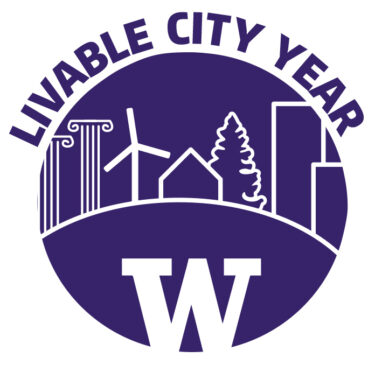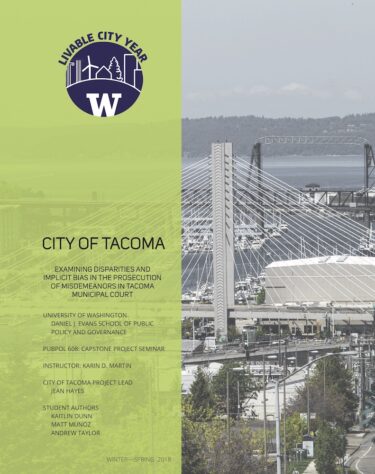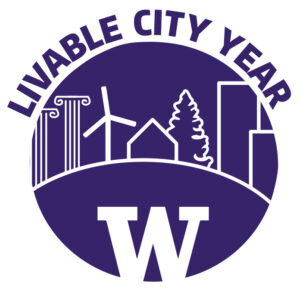Addressing Implicit Bias in the Prosecution of Cases
Livable City Year 2017-2018 – City of Tacoma
UW Faculty: Karin D. Martin, Evans School of Public Policy and Governance
City Project Lead: Jean Hayes, City Attorney’s Office, Prosecution Division
Project summary
In fall 2017, the Tacoma City Attorney’s Office contracted with the University of Washington Livable City Year (LCY) and the University of Washington Evans School of Public Policy and Governance. In particular, the City Attorney’s Office sought to address disparities in sentencing outcomes occurring due to defendant race, mental health status, and socioeconomic status, and the presence of implicit bias within the court system. Racial, mental health, and socioeconomic-related disparities are well-documented in the criminal justice system and can occur at many decision points, from initial arrest to incarceration and probation for misdemeanor offenses. At the time of this report, no such research exists for the City of Tacoma.
The goals of this report are fourfold:
- Quantify racial disparities in sentencing outcomes for misdemeanor cases in Tacoma Municipal Court
- Examine implicit bias among prosecutors and public defenders
- Provide an assessment of prosecutors and public defender’s perceptions of racial, mental health and socioeconomic disparities and biases in Tacoma Municipal Court
- Provide preliminary recommendations to the City Attorney’s Office and the City of Tacoma that address race, mental health, and income-related disparities in addition to implicit bias in Tacoma Municipal Court
Quantitative analyses indicated that racial disparities exist for multiple sentencing outcomes in the City of Tacoma. In particular, depending on the presiding official, Native American defendants were more likely than similarly situated White defendants to incur higher fines and serve jail time, and less likely to have their fines reduced from the citation. Similarly, depending on presiding official, Black and Asian defendants were more likely than similarly situated White defendants to incur higher citations.
According to results from the Implicit Association Test (IAT) that we administered to prosecutors and public defenders, the City Attorney’s Office has an overall moderate preference for distinctive White names and the Department of Assigned Counsel has an overall slight preference for distinctive White names, demonstrating that there is evidence of implicit bias within the court system. The strength of implicit bias of prosecutors and public defenders in Tacoma Municipal Court is consistent with broader patterns that have been observed nationally.
Semi-structured interviews with defense and prosecuting attorneys
gave a more nuanced view of racial, mental health, and socioeconomic disparities, and biases in Tacoma Municipal Court. Attorneys in both offices reported some level of observed disparities in Tacoma Municipal Court, but on average, public defenders were more definitive about the existence of disparities and went into to more detail than the prosecutors about experiences of disparities. Additionally, socioeconomic disparities were the most commonly mentioned type of disparity between the two offices, though attorneys in both offices also mentioned that they perceive these disparities to be linked with racial and mental health characteristics.
While these disparities cannot be directly linked to bias, public defenders and prosecutors spoke to the existence of microaggressions from judges in Tacoma Municipal Court and police officers in the City of Tacoma. Additionally, attorneys in both offices spoke to the cyclical nature of socioeconomic status and criminal history, and how the inability to pay for court fees and fines often leads not only to future cases, but also more severe outcomes for defendants in those future cases. Finally, individuals from the two offices identified the courtroom in which defendants find themselves, as well as varying philosophies of fairness between the attorneys and between the judges as barriers to fair outcomes. One prosecutor connected these themes when they reported that in Tacoma Municipal Court:
“[w]e’re dealing with more implicit bias…I think some people can acknowledge it and some have more difficulty…. I see it more playing out about people with money versus people with none.”
Part of the 2017-2018 Livable City Year partnership between the University of Washington and the City of Tacoma.
See all Livable City Year projects in Tacoma that UW students and faculty worked on during the year-long partnership.






